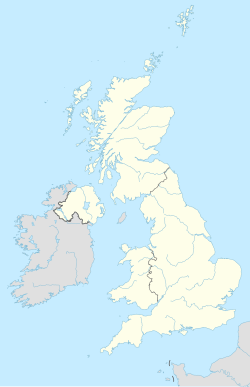RAF Penrhos
This article needs additional citations for verification. (February 2013) |
| RAF Penrhos | |||||||||||
|---|---|---|---|---|---|---|---|---|---|---|---|
| Located next to Penrhos, in the community of Llanbedrog, Gwynedd Near Pwllheli, 3 miles (5 km) to the east, in Wales | |||||||||||
| Coordinates | 52°52′26″N 004°28′26″W / 52.87389°N 4.47389°W | ||||||||||
| Type | Royal Air Force station Observers Advanced Flying Unit | ||||||||||
| Site information | |||||||||||
| Owner | Air Ministry | ||||||||||
| Operator | Royal Air Force | ||||||||||
| Controlled by | RAF Flying Training Command | ||||||||||
| Site history | |||||||||||
| Built | 1936 | ||||||||||
| In use | 1937-1946 | ||||||||||
| Battles/wars | European theatre of World War II | ||||||||||
| Garrison information | |||||||||||
| Occupants | 1944 Officers - 117 (11 WAAF) Other Ranks - 1,134 (245 WAAF)[1] | ||||||||||
| Airfield information | |||||||||||
| Elevation | 16 metres (52 ft) AMSL | ||||||||||
| |||||||||||

Royal Air Force Penrhos, or more simply RAF Penrhos, is a former Royal Air Force airfield located near Penrhos, Gwynedd and 14.7 miles (23.7 km) west of Porthmadog, Gwynedd, Wales, in the community of Llanbedrog.
It was operational from 1 February 1937 to 21 October 1946 for armament training, air observer, bombing and gunnery schools.[2]
History
[edit]In 1936 a decision was taken to establish an RAF bombing school at Penyberth, a farm of about 250 acres (101 ha) for RAF Penrhos which was purchased by the Air Ministry,[3] including the area of the low plateau in the bend of the river where the Afon Penrhos joins the Afon Geirch. Opposition was strongly felt, particularly as it was perceived that the sixteenth century house, Penyberth was, in Saunders Lewis’ words, 'one of the essential homes of Welsh culture, idiom and literature'.[4] As work proceeded, an arson attack was carried out on 8 September 1936[3] after which the arsonists gave themselves up at Pwllheli Police Station. Despite this the base came into operation in February 1937.[2]
In December 1940 a detachment from No. 312 (Czechoslovak) Squadron was moved to protect Penrhos from German attack.[5] This association led in later years to the Polish Resettlement Corps using the site to house Polish soldiers, sailors and airmen who chose not to return to communist Poland. To this day, part of RAF Penrhos is in use as an old people's home for elderly Poles.
RAF Hell's Mouth, 5 miles (8 km) to the south west, was commissioned in February 1937 as a Relief Landing Ground, later an Emergency landing Ground, for RAF Penrhos.
Units
[edit]During the course of the operation of the station, the following units were at sometime based at RAF Penrhos:
- 'C' Flight of No. 1 Anti-Aircraft Co-operation Unit RAF (1 AACU)[2]
- 'J' Flight of No. 1 Anti-Aircraft Co-operation Unit RAF (1 AACU)[2]
- No. 1 Air Observers School RAF[2]
- No. 2 Air Crew Holding Unit RAF[2]
- No. 2 Service Flying Training School RAF.[2]
- No. 5 Armament Training Camp RAF with Westland Wallaces[6]
- No. 5 Armament Training Station RAF[2]
- No. 5 Flying Training School RAF[2]
- No. 5 Service Flying Training School RAF[2]
- No. 6 Flying Training School RAF[2]
- No. 6 Service Flying Training School RAF[2]
- No. 9 Air Observers School RAF with Handley Page Harrows and Fairey Battles the unit was renamed No. 9 Bombing & Gunnery School two months later[6]
- No. 9 (Observers) Advanced Flying Unit RAF[2]
- No. 9 Service Flying Training School RAF[2]
- No. 10 Flying Training School RAF[2]
- No. 10 Service Flying Training School RAF[2]
- No. 11 Service Flying Training School RAF[2]
- No. 12 Flying Training School RAF[2]
- No. 12 Operational Training Unit RAF[2]
- No. 12 Service Flying Training School RAF[2]
- No. 63 Squadron RAF[7]
- No. 258 Squadron RAF[8]
- A detachment of No. 312 (Czechoslovak) Squadron RAF with Hawker Hurricanes until April 1941[9]
- No. 2780 Squadron RAF Regiment[2]
- Signals Instructor School RAF[2]
During the late 1980s privately owned aircraft used to land here during the summer on a 400-yard tarmac strip.[9]
Current use
[edit]Part of the site is now Pen-y-berth caravan park.
References
[edit]Citations
[edit]- ^ Delve 2007, p. 226.
- ^ a b c d e f g h i j k l m n o p q r s t u v "Penrhos". Airfields of Britain Conservation Trust. Retrieved 12 August 2023.
- ^ a b "Polish Home, Llanbedrog (306520)". Coflein. RCAHMW. Retrieved 11 August 2023.
- ^ Davies 1994, p. 592.
- ^ Sitenský, Ladislav (1991). Z válečného deníku [From a War Diary] (in Czech). Praha: Naše vojsko. p. 78. ISBN 80-206-0247-X. with photographs of RAF Pernhos on pages 105-106
- ^ a b Smith 1990, p. 134.
- ^ Jefford 1988, p. 44.
- ^ Jefford 1988, p. 79.
- ^ a b Smith 1990, p. 135.
Bibliography
[edit]- Annand, David. RAF Penrhos near Pwllheli 1937-45 and RAF Llandwrog near Caernarvon 1940-45. Tywyn : David Annand, 1986.
- Davies, John (1994). A History of Wales. Penguin Books. ISBN 0-14-014581-8.
- Delve, Ken (2007). The Military Airfields of Britain Wales and West Midlands. Marlborough, Wiltshire UK: The Crowood Press Ltd. ISBN 978-1-86126-917-1.
- Jefford, C G (1988). RAF Squadrons. A comprehensive record of the movement and equipment of all RAF squadrons and their antecedents since 1912. Shrewsbury: Airlife. ISBN 1-85310-053-6.
- Smith, D J (1990). Action Stations: Vol 3. Military airfields of Wales and the North-West. Wellingborough: Patrick Stephens Limited. ISBN 1-85260-375-5.
- [1]

